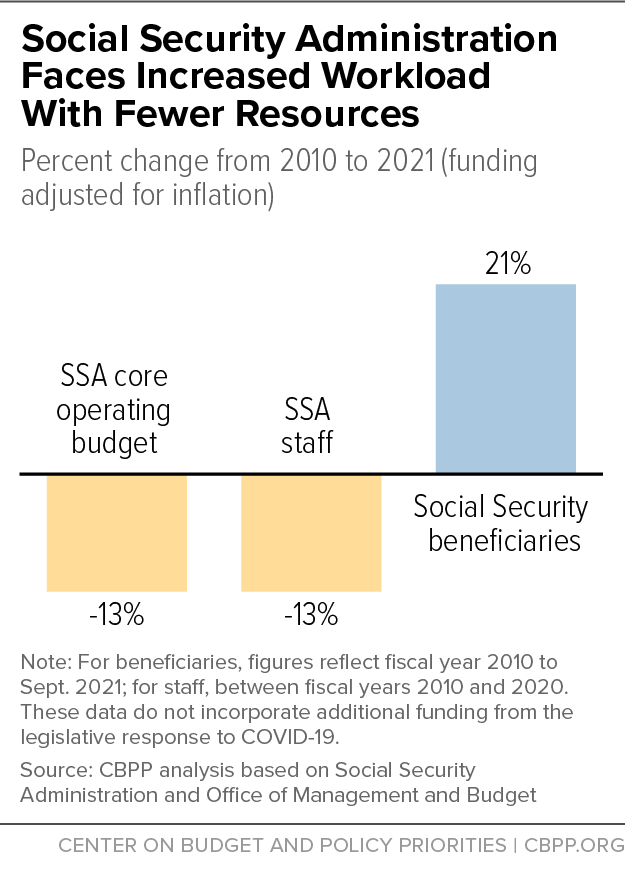BEYOND THE NUMBERS
The Social Security Administration (SSA) has suffered from over a decade of underinvestment, compounded by the COVID pandemic. Appropriations for 2022 are an opportunity for policymakers to begin making significant reinvestments in the agency, not least to ensure that its planned resumption of in-person service goes smoothly and safely and that it adequately serves applicants and beneficiaries left behind during the pandemic.
The House-passed appropriations bill for the departments of Labor, Education, and Health and Human Services (HHS) would boost SSA’s funding by 9 percent over last year, while the Senate version (released by Senate Appropriations Committee Chairman Leahy) would provide an 8 percent increase — less than the 10 percent increase proposed in President Biden’s 2022 budget.
These funding increases would begin to make up for more than a decade of inadequate SSA funding. The agency’s operating budget fell 13 percent in inflation-adjusted terms from 2010 to 2021, even as the number of Social Security beneficiaries grew by 21 percent. Austere caps on discretionary funding contributed to the problem, but even when there was bipartisan agreement to raise the caps in 2020 and 2021, SSA’s operating budget didn’t keep up with inflation.
As we have documented over the years, budget cuts have hampered SSA’s ability to perform essential services such as determining eligibility in a timely manner for retirement, survivor, and disability benefits; paying benefits accurately and on time; responding to questions from the public; and updating benefits promptly when circumstances change.
The COVID-19 pandemic compounded the effects of long-term underinvestment in SSA. SSA closed its field offices to the public in March 2020 to protect its staff and its customers, who are largely older and disabled and at the highest risk of COVID-19 complications. Even now, field offices are only open on a very limited basis for in-person service, and the agency will need to take significant (and likely costly) precautions as it continues to reopen. SSA received supplemental funds to support its short-term responses to the crisis, such as switching abruptly to teleservice and helping the IRS distribute economic impact (stimulus) payments.
But a one-time funding boost won’t be enough for an agency that struggled to serve applicants and beneficiaries before the pandemic. Nor will it be enough to deal with COVID-19’s longer-term fallout.
For example, applications for disability benefits are sure to ramp back up after they plummeted over the past year, especially among those who most need in-person assistance: people who are elderly, experiencing homelessness, or have limited English proficiency. An estimated 500,000 fewer people receive Supplemental Security Income (SSI) and Social Security Disability Insurance benefits than would have been expected based on recent trends. SSA is starting more robust outreach to potential applicants but will need added funding to reach those left behind — before and during the pandemic.
Also, the long-term effects of COVID-19 will likely increase disability applications. COVID-19 has disabling effects on many who contract it, including lung scarring, heart damage, and neurological and mental health effects. SSA will need to process these complicated new disability claims and any delayed claims from people who otherwise would have claimed in the past two years.
SSA already faces a backlog in appeals from people whose disability applications it denied, and the agency anticipates many more appeals stemming from the expected influx in applications. Even as applications for disability benefits have declined, processing times and backlogs for disability claims are growing. For example, the average processing time for initial disability claims increased 46 percent (from 95.5 days to 139.4 days) during the pandemic, according to the SSA Office of the Inspector General. Additional funding is needed to hire more staff to decide disability claims and appeals and reduce this backlog.
SSA has also been making necessary technological improvements to provide more options for applicants and beneficiaries, such as scheduling appointments online; to update antiquated and inefficient IT systems; and to improve payment accuracy. Further investments in these long-term modernization projects are essential.
During the pandemic, SSA necessarily suspended some non-essential work, like continuing disability reviews (CDRs) to determine whether disability beneficiaries are still eligible for benefits. But SSA must conduct CDRs on a certain schedule, so the agency — which reduced a previous CDR backlog before the pandemic using additional program integrity funding — now has a new backlog. The House and Senate appropriations bills, like the President’s budget, request $133 million in added funding for program integrity work.
Policymakers can make a down payment on rebuilding SSA and addressing new pandemic-related challenges by providing robust funding for essential SSA services in the Labor, Education, and HHS appropriations bill for 2022.

